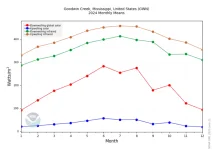Ld is longwave downwards radiation. The GCM simulations that the IPCC uses are bias corrected from measured observations. All of the values you mention above either measured or calculated are far above the 240 that you say is the most they can be.
The 342 you cite here is incoming solar radiation, not Ld.
They calculated it from the solar constant which is measured. There is no problem with the calculation. See below at end.
I don’t believe that absorbed solar radiation includes reflected shortwave (solar) radiation. They are shown separately.
View attachment 67573928
The only diagrams I have seen show some sunlight being absorbed by the atmosphere but most at the surface as above. What diagrams are you referring to?
The approximately circular disc of the Earth, as viewed from the Sun, receives a roughly stable 1361 W/m2 at all times. The area of this circular disc is π
r2, in which r is the radius of the Earth. Because the earth is approximately spherical, it has total area
, meaning that the solar radiation arriving at the top of the atmosphere, averaged over the entire surface of the Earth, is simply divided by four to get 340 W/m2. In other words, averaged over the year and the day, the Earth's atmosphere receives 340 W/m2 from the Sun.






